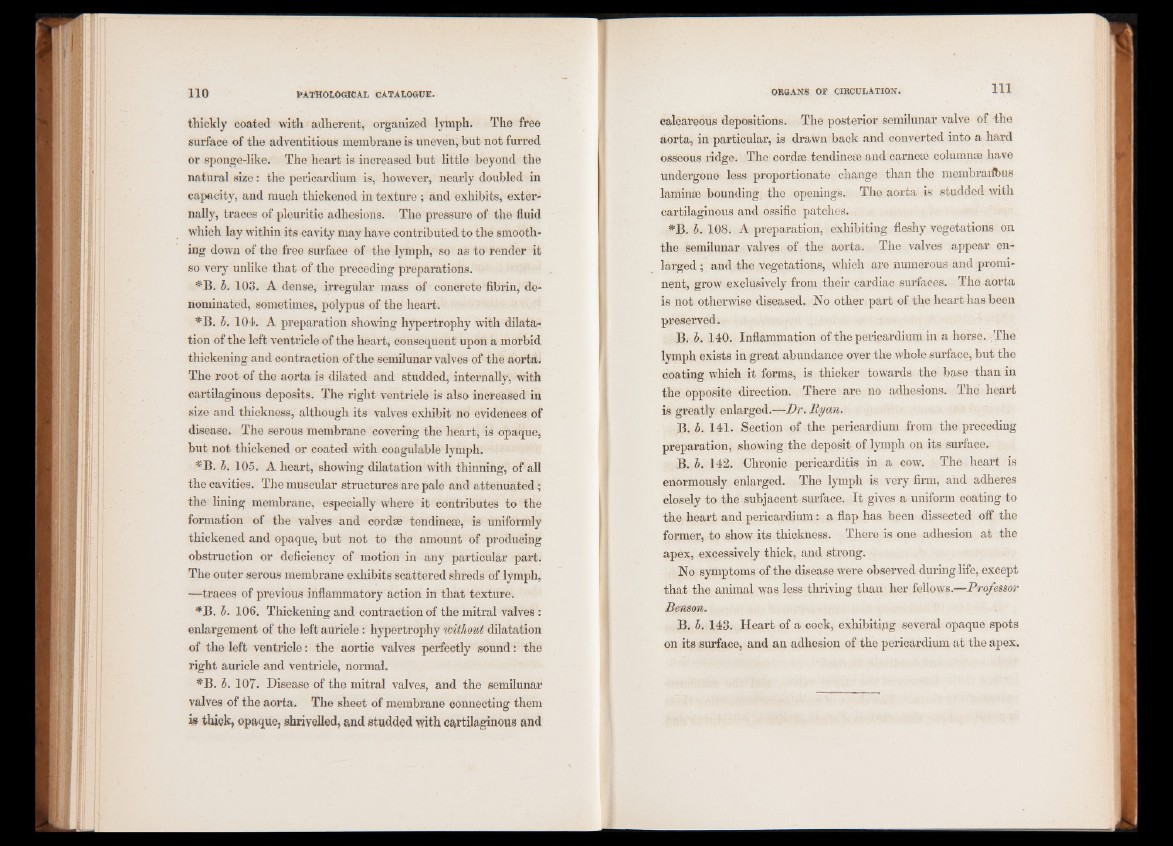
thickly coated with adherent, organized lymph. The free
surface of the adventitious membrane is uneven, but not furred
or sponge-like. The heart is increased but little beyond the
natural size: the pericardium is, however, nearly doubled in
capacity, and much thickened in texture ; and exhibits, externally,
traces of pleuritic adhesions. The pressure of the fluid
which lay within its cavity may have contributed to the smoothing
down of the free surface of the lymph, so as to render it
so very unlike that of the preceding preparations.
#B. b. 103. A dense, irregular mass of concrete fibrin, denominated,
sometimes, polypus of the heart.
*B. b. 104. A preparation showing hypertrophy with dilatation
of the left ventricle of the heart, consequent upon a morbid
thickening and contraction of the semilunar valves of the aorta.
The root of the aorta is dilated and studded, internally, with
cartilaginous deposits. The right ventricle is also increased in
size and thickness, although its valves exhibit no evidences of
disease. The serous membrane covering the heart, is opaque,
but not thickened or coated with eoagulable lymph.
*B. b. 105. A heart, showing dilatation with thinning, of all
the cavities. The muscular structures are pale and attenuated;
the lining membrane, especially where it contributes to the
formation of the valves and eordae tendinese, is uniformly
thickened and opaque, but not to the amount of producing
obstruction or deficiency of motion in any particular part.
The outer serous membrane exhibits scattered shreds of lymph,
—traces of previous inflammatory action in that texture.
#B. b. 106. Thickening and contraction of the mitral valves :
enlargement of the left auricle: hypertrophy without dilatation
of the left ventricle: the aortic valves perfectly sound: the
right auricle and ventricle, normal.
#B. b. 107. Disease of the mitral valves, and the semilunar
valves of the aorta. The sheet of membrane connecting them
is thick, opaque, shrivelled, and studded with cartilaginous and
calcareous depositions. The posterior semilunar valve of the
aorta, in particular, is drawn back and converted into a hard
osseous ridge. The cordse tendinese and earneee columnar have
undergone less proportionate change than the membrarfbus
lamina; bounding; the openings. The aorta is studded with
cartilaginous and ossific patches.
#B. b. 108. A preparation, exhibiting fleshy vegetations on
the semilunar valves of the aorta. The valves appear enlarged
; and the vegetations, which are numerous and prominent,
grow exclusively from their cardiac surfaces. The aorta
is not otherwise diseased. No other part of the heart has been
preserved.
B. b. 140. Inflammation of the pericardium in a horse. :The
lymph exists in great abundance over the whole surface, but the
coating which it forms, is thicker towards the base than in
the opposite direction. There are no adhesions. The heart
is greatly enlarged.—Dr. My an.
B. b. 141. Section of the pericardium from the preceding
preparation, showing the deposit of lymph on its surface,
B. b. 142. Chronic pericarditis in a cow. The heart is
enormously enlarged. The lymph is very firm, and adheres
closely to the subjacent surface. It gives a uniform coating to
the heart and pericardium: a flap has been dissected off the
former, to show its thickness. There is one adhesion at the
apex, excessively thick, and strong.
No symptoms of the disease were observed during life, except
that the animal was less thriving than her fellows.—Professor
Benson.
B. b. 143. Heart of a cock, exhibiting several opaque spots
on its surface, and an adhesion of the pericardium at the apex.